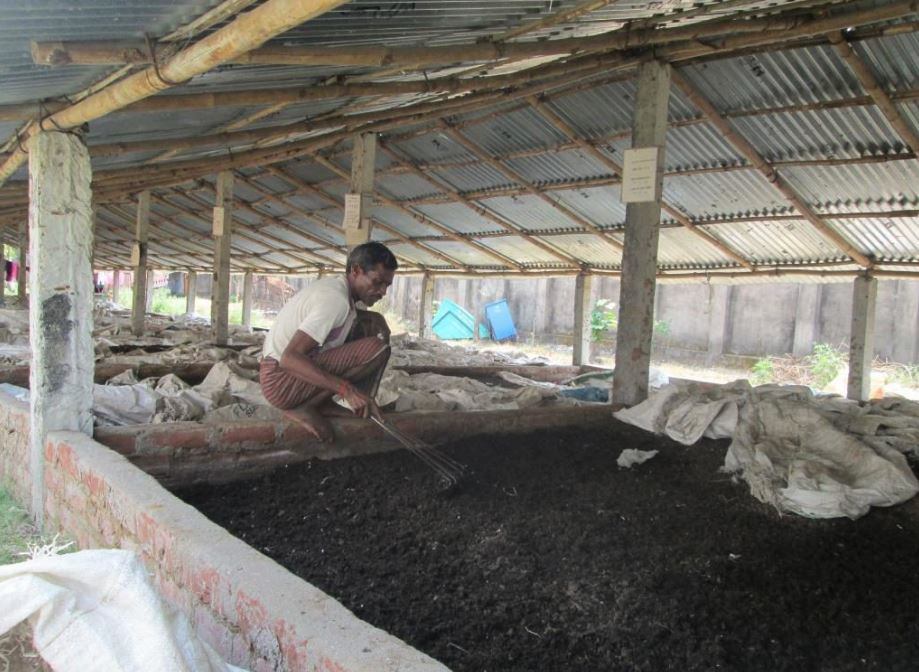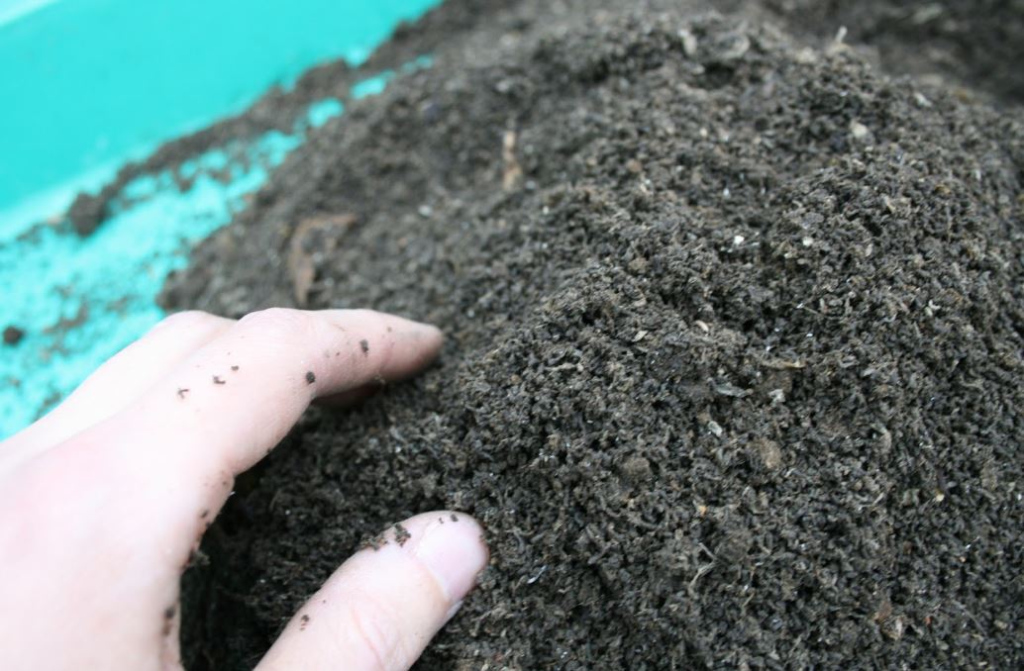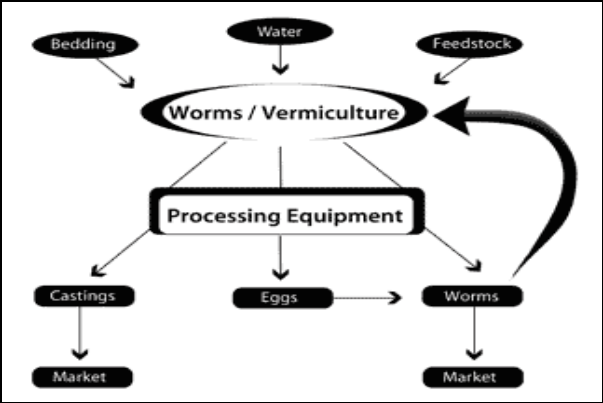Vermicomposting is the process of turning organic debris into worm castings. The worm castings are very important to the fertility of the soil. The castings contain high amounts of nitrogen, potassium, phosphorus, calcium, and magnesium. Castings contain 5 times the available nitrogen, 7 times the available potash, and 1 ½ time more calcium than found in good topsoil.
Several researchers have demonstrated that earthworm castings have excellent aeration, porosity, structure, drainage, and moisture-holding capacity. The content of the earthworm castings, along with the natural tillage by the worms burrowing action, enhances the permeability of water in the soil. Worm castings can hold close to nine times their weight in water. “Vermiconversion,” or using earthworms to convert waste into soil additives, has been done on a relatively small scale for some time. A recommended rate of vermicompost application is 15-20 percent. Vermicomposting is done on small and large scales.
Vermicomposting and Its Use
Vermicompost is nothing but the excreta of earthworms, which is rich in humus and nutrients. We can rear earthworms artificially in a brick tank or near the stem/trunk of trees (especially horticultural trees). By feeding these earthworms with biomass and watching properly the food (bio-mass) of earthworms, we can produce the required quantities of vermicompost.
Properties of Vermicomposting ( Bio Vermi )
-
Vermicompost is rich in all essential plant nutrients.
-
It provides an excellent effect on overall plant growth, encourages the growth of new shoots/leaves, and improves the quality and shelf life of the produce.
-
Bio Vermi is free-flowing, easy to apply, handle and store and does not have a bad odor.
-
It improves soil structure, texture, aeration, and water-holding capacity and prevents soil erosion.
-
Bio Vermi is rich in beneficial microflora such as fixers, P- solubilizers, cellulose decomposing micro-flora, etc in addition to improving the soil environment.
-
Bio Vermi contains earthworm cocoons and increases the population and activity of earthworms in the soil.
-
It neutralizes soil protection. It prevents nutrient losses and increases the use efficiency of chemical fertilizers. Bio Vermi is free from pathogens, toxic elements, weed seeds, etc. Bio Vermi minimizes the incidence of pests and diseases. It enhances the decomposition of organic matter in the soil. It contains valuable vitamins, enzymes, and hormones like auxins, gibberellins, etc.
Common nutrient value of Bio Vermi
|
Organic carbon |
9.5 – 17.98 % |
|
C/N ratio |
11.64 |
|
Nitrogen |
0.5 – 1.5 % |
|
Phosphorus |
0.1 – 0.30 % |
|
Potassium |
0.15 – 0.56 % |
|
Sodium |
0.06 – 0.30 % |
|
Calcium and magnesium |
22.67 – 47.60 meq/100g |
|
Copper |
2 – 9.50 mg Kg-1 |
|
Iron |
2 – 9.30 mg Kg-1 |
|
Zinc |
5.70 – 11.50 mg Kg-1 |
|
Sulphur |
128 – 548 mg Kg-1 |
Use and Application of Vermicompost
Vermicomposting is a process in which earthworms are used to convert organic materials into humus‐like material known as vermicompost. Several researchers throughout the world have found that the nutrient profile in vermicompost is generally higher than in traditional compost. Vermicompost can enhance soil fertility physically, chemically, and biologically. Physically, vermicompost‐treated soil has better aeration, porosity, bulk density,d, and water retention. Chemical properties such as pH, electrical conductivity, and organic matter content are also improved for better crop yield. Although vermicomposts have been shown to improve plant growth significantly. Therefore, vermicomposts should be applied at moderate concentrations to obtain maximum plant yield.
Vermicompost process of manufacturing
Different stages of Vermicomposting
-
Stage 1
Pre-preparation includes the collection of wastes of degradable waste from the undegradable waste.
-
Stage 2
Digestion of collected waste for about a month till the heaping of along with the cow dung slurry, this digested material is fit for earthworms consumption.
-
Stage 3
A cement base is needed for putting the waste for compost preparation. Allow worms to go inside the soil for loosening the soil with watering.
-
Stage 4
Collect the worms from the concrete base after collection of the prepared compost.
-
Stage 5
Storage of prepared compost in the appropriate place so that moisture can be maintained along with the growth of micro-organisms.
Earthworms for Vermicomposting
Earthworms live in the soil and feed on decaying organic material. After digestion, the undigested material moves through the alimentary canal of the earthworm, and a thin layer of oil is deposited on the castings. This layer erodes over 2 months

Site selection for vermicomposting
A suitable place is needed for Vermicomposting. You can choose a shady place that has high humidity and cool weather.
Container for vermicomposting or composting bins
To collect compost production, you should have an open place like a container or Composting bin to place the prepared compost and give some time so that micro-organisms can activate on the manure and make it more fertile than the previous one. Since humidity must be maintained during this period, the growth of microorganisms becomes more.

One can also prepare a cement open block that is 3 feet higher and has the same or wider. The room should be sloppy so that water can be collected at one end and can be reused.
Bed for Vermicomposting
If you are preparing compost with the help of worms then, you must have to take care of them. But how? and what should be Vermicompost bed size? So, prepare a bed for them by placing sawdust, sugarcane trash, husk, and coir waste in the prepared container. The thickness should be or can keep up to 3-5 cm. Then after, a layer of fine sand of the same thickness is to be spread over that which is followed by the garden soil, most of the same size. Take care that all layers must be moistened with water.
Common food for Earthworms
Manures are the best and preferred food for the compost worms which include the cattle manure, poultry manure, sheep or goat manure, hog manure, rabbit manure, fresh food scraps like peels, leftover commercial food processing waste, pre-composted food waste, biosolids as human waste, seaweed, legume hays, corrugated cardboard, fish and poultry offal like animal mortalities.
Raw material for vermicomposting
All the food used by the compost worm is the raw material since all food, eaten by them is not used by the worms. Only 5 to 10 percent of them is used by them and all the remaining extra food is excreted through their body cell. You can use everything as raw material which can be biodegradable. Since worms used only the degradable waste as their food, letting the remaining.
Idle Conditions for Earthworms in Compost Material
Here below are some idle conditions for preparing vermicompost
- A pH range should be between 6.5 and 7.5 along with moisture content of 60-70% below and above range mortality of worms taking place.
- Suitable aeration should be 50% of the total pore space.
- Temperature range of 19 to 35°Cis suitable for best production.
Precautions while Vermicomposting
Here below are some points to consider, for a profitable vermiculture business.
- The compost pit should be protected from direct sunlight and a certain temperature has to be maintained.
- Make sure that the addition of higher quantities of acid-rich substances such as citrus wastes should be avoided.
- Make sure to have a drainage channel around the heap to avoid stagnation of water particularly in high rainfall areas in the rainy season.
- Always maintain the moisture level by watering.
- Avoid worms predator like a crane. As they will lessen your profit
- The worms should be protected from the natural predators
- Make sure that compost beds/heaps are not covered with plastic sheets/material since this can trap heat and gases.
- Should not overload the vermicompost heap to avoid high temperature that adversely affects their population.
- Water stress or dry conditions kill the earthworms. Make sure to water daily in summer and every third day in the rainy and winter seasons to supply continuous moisture to the beds.
- Use organic materials in composting which is free from materials such as stones, glass pieces, plastics, and ceramic tubes.
- So, these are the main precaution for a profitable vermiculture business. Take care of them.
How to collect vermicompost
From the container (composting bins), you can take out the prepared compost at the same interval of time like a week or a gap of 10 days. Taking care of the worms should not come with the compost. Check the quality of compost and prepared compost must be taken out when it is prepared so that worms yield more and more compost.
Many asked how long does it take to make compost? You can collect that prepared compost from composting bin after about three to four-month of starting this composting process.
Storing and packing of Vermicompost
Compost should be stored in a dark and cool place maintaining moisture at about 40%. prevent that compost from sunlight because it will lead to nutrient loss along with lowering the moisture of the compost. It is preferred that try to keep store the compost in an open darkroom rather than a closed sector. Must take care of maintaining the moisture level of prepared compost.

Flo chart of Vermicomposting

